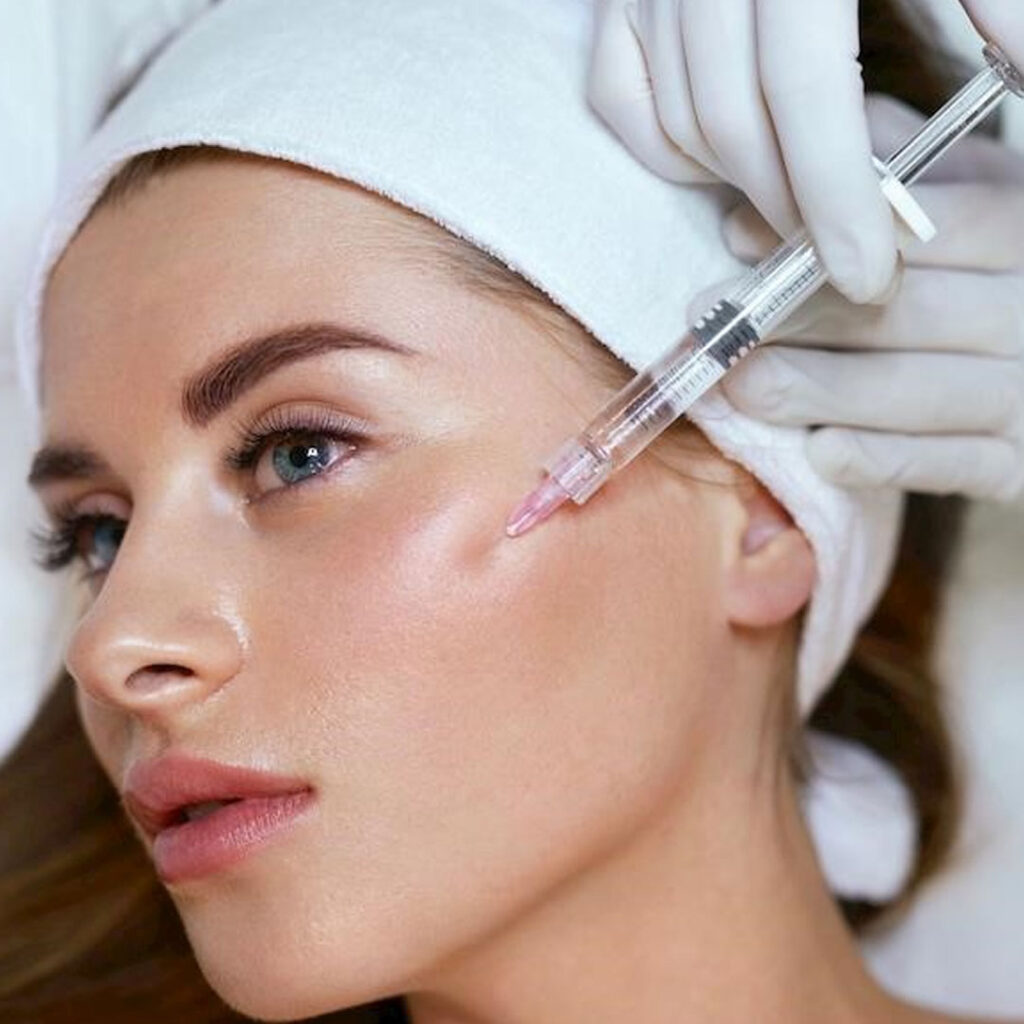Dermal Fillers

Enhance Your Natural Features With Dermal Filler Injections
Dermal fillers are cosmetic treatments that are used to enhance the appearance of the skin. They work by adding volume to specific areas of the face, such as the cheeks, lips, and lower face. The fillers are made of hyaluronic acid, a naturally occurring substance in the body that helps to hydrate and plump the skin.
Dermal fillers are a popular non-invasive cosmetic procedure that can be used to address a range of concerns, including fine lines and wrinkles, sunken cheeks, thin lips, and hollow under-eye area. The treatment results are immediate, giving the face a more refreshed appearance.
Dermal fillers are a versatile cosmetic treatment that can be tailored to meet the individual’s specific needs and goals. Different types of fillers are available, each with different properties and benefits, making it easy to find a treatment that is right for you.
It is important to choose a qualified and experienced practitioner to perform the treatment, as injecting dermal fillers requires skill and expertise. It is also important to discuss your goals and expectations with your practitioner before the treatment to ensure you are satisfied with the results.
Benefits of Dermal Fillers
Dermal fillers offer a range of benefits for those looking to enhance the appearance of their skin. Some of the key benefits of this cosmetic treatment include:

Reduced fine lines and wrinkles
Dermal fillers can help to reduce the appearance of fine lines and wrinkles, giving the skin a smoother appearance.

Increased volume
The treatment can also be used to add volume to specific areas of the face, such as the cheeks and lips, creating a more plump appearance.

Non-invasive
Dermal fillers are a non-invasive cosmetic procedure, making them a great option for those who want to achieve a more natural look without surgery.

Immediate results
The results of dermal filler treatment are immediate and can last for several months, depending on the type of filler used and the individual’s lifestyle and skincare routine.

Customizable
Dermal fillers can be customized to meet the individual’s specific needs and goals, allowing for a tailored and personalized approach to treatment.
Dermal fillers offer a range of benefits for those looking to enhance the appearance of their skin, reduce the appearance of fine lines and wrinkles, and add volume to specific areas of the face. The non-invasive nature of the treatment, combined with its immediate and customizable results, make it a popular choice for those seeking a more refreshed appearance.

How It Works?
Dermal fillers work by injecting a soft, gel-like substance into the skin to add volume and reduce the appearance of fine lines and wrinkles. The substance used in dermal fillers is usually hyaluronic acid, a naturally occurring substance in the body that helps to hydrate and plump the skin.
During the procedure, the practitioner will use a fine needle or cannula to carefully inject the filler into specific areas of the face, such as the cheeks, lips, or lower face. The practitioner will use their expertise to carefully place the filler in the right areas, adding volume and reducing the appearance of fine lines and wrinkles.
The results of dermal filler treatment are immediate and can last for several months, depending on the type of filler used and the individual’s lifestyle and skincare routine. Over time, the hyaluronic acid in the filler will gradually be absorbed by the body, and the skin will return to its original appearance.
Treatment Areas
Common treatment areas include cheeks, lips, under-eye hollows, nasolabial folds, marionette lines, jawline, temples, and chin. Fillers can also be used for non-surgical nose reshaping and earlobe rejuvenation. Our registered medical professional will determine the specific areas to be treated and the type of filler used during a consultation based on the individual’s desired results and facial anatomy.
Pricing
Lips From $500
Cheeks From $600
Marionette LinesFrom $600
"Sad Lines" that form on the corners of the mouth & go down to the chin.
ChinFrom $600
JawlineFrom $600
Peri-Oral Smokers LinesFrom $500
Lines around the mouth.
Before and After
People often suffer from signs of ageing, lack of volume, wrinkles, fine lines and hollow areas before seeking dermal fillers. They enhance facial contours and symmetry, restore volume loss due to ageing, and provide immediate and long-lasting results. Fillers can also be used for non-surgical lip augmentation and cheek contouring.
Before the procedure, please keep these points in mind –
- Avoid Alcohol and smoking for 24 hours
- Schedule the procedure at least two weeks before a special occasion or event.
- Avoid taking anti-inflammatory medication.
- Avoid treatment if you have active infections in the treatment area.
- You must wait four weeks between having cosmetic injectables and significant dental work.
- You must be planning on staying in the local area post-dermal filler for two weeks post-treatment.
- You must wait four weeks between getting covid/having a vaccination and having dermal filler;
Post the procedure; please keep these points in mind –
- Do not rub or touch the treated area until the following day.
- Do not consume alcohol for 24 hours after the treatment.
- Avoid strenuous exercise for 24 hours after treatment.
- It is recommended to avoid extended exposure to sun or UV light and extreme hot or cold temperatures, including hot drinks, if your lips have been treated. Avoid facial laser treatment to the treated area for up to four weeks.
- For cheek augmentation, it is recommended to avoid restrictive headwear, including goggles, sunglasses or motorcycle helmets, for up to four weeks.
- It is recommended to wait to apply makeup to the treatment area until 24 hours post-treatment.
- There will be some swelling and bruising, however, do not worry, as it will only be temporary. Arnica tablets or Hirudoid cream can help reduce bruising.
- You may feel lumps for up to 2 weeks as your body adjusts to the new volume. If you can see any lumps and have concerns, please contact Monique.
- It may take two weeks to see the full results.
FAQs
What are Dermal Fillers?
Dermal fillers are non-surgical cosmetic treatments used to plump and smooth wrinkles, fine lines, and sunken areas of the skin, giving a more youthful appearance. They are made of a substance called hyaluronic acid.
Which areas can be treated with Dermal Fillers?
Dermal fillers can treat various areas of the face, including the lips, cheeks, nasolabial folds, marionette lines, under-eye hollows, and jawline. They can also enhance features such as the nose, chin, and temples.
What are they made of?
Dermal fillers are made of hyaluronic acid.
Are Dermal Fillers safe?
With any medical procedure, there is a risk of complications, so it’s important to fully understand the potential risks and benefits before deciding to have treatment.
Do Dermal Fillers hurt?
Dermal fillers can cause discomfort during the injection, but most people find the procedure relatively painless. Your practitioner may use a numbing cream to minimise any pain.
How do I know if Dermal Fillers are right for me?
Dermal fillers can be a good option for those looking to reduce the appearance of fine lines and wrinkles and enhance certain facial features. To determine if fillers suit you, you must consult the Glow team to discuss your concerns, goals, and medical history.
How long do Dermal Fillers last?
The longevity of dermal fillers varies depending on the type of filler used and the area being treated. On average, most fillers last 6-12 months before the body naturally breaks down and absorbs the product. Some longer-lasting fillers can last up to 2 years.
What happens if I stop?
The effect slowly wears off as the body naturally breaks down and absorbs the product. The length of time this takes will depend on the type of filler used and the individual’s metabolism.
How much does this cost?
They can cost anything from $400-$600.
Are side effects different between brands?
Yes, there is a difference. This is due to the fillers’ composition, formulation, and molecular structure. Some of the dermal fillers’ most common side effects include swelling, bruising, redness, and tenderness at the injection site.
How should I prepare for Dermal Filler treatment?
First, a consultation with the Glow professional is a must. It’s also a good idea to avoid alcohol, blood thinners, and non-steroidal anti-inflammatory drugs for at least 24 hours before treatment to minimise the risk of bleeding and swelling.
What is the aftercare for Dermal Filler treatment?
Avoiding alcohol, strenuous activity, and direct sun exposure for a specified period of time are the basics. You may also be advised to apply cold compresses or ice to the treated area to reduce swelling and tenderness. It’s also a good idea to avoid massaging or manipulating the treated area, as this could affect the placement of the filler.
Are there any side effects after having Dermal Fillers?
Yes, there can be side effects after having dermal fillers. Some of the most common side effects include swelling, bruising, redness, tenderness, and itching at the injection site.
Do Dermal Fillers cause the skin to sag?
No, dermal fillers do not cause the skin to sag. They can help to enhance and rejuvenate facial features by adding volume and smoothing out wrinkles and fine lines.
Can I fly after the Dermal Filler treatment?
You must be near by for 2 weeks post treatment incase of any adverse event.
Can I have Filler dissolved at the clinic?
Yes. This is a quick and effective way to reverse the effects of dermal fillers if you are not satisfied with the results or have experienced any side effects. However, not all types of fillers can be dissolved, so it’s important to discuss your options with your practitioner.
Can I get cosmetic injectable treatments while pregnant?
It is not recommended to get cosmetic injectable treatments, such as dermal fillers, while pregnant or breastfeeding. This is because there is limited research on the safety of these treatments for pregnant or breastfeeding individuals, and the effects on the developing fetus or breastfed infant are unknown. If you are pregnant or breastfeeding, it’s important to discuss your options with your practitioner and avoid any treatments that have not been specifically approved for use during pregnancy or breastfeeding.

